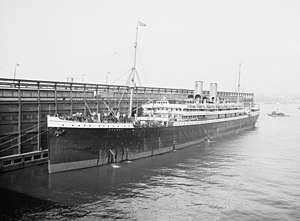SS Bremen (1896)
The SS Bremen, later renamed Constantinople and then King Alexander, was a German Barbarossa class ocean liner commissioned in 1897 by Norddeutscher Lloyd.
 | |
| History | |
|---|---|
| Name: | SS Bremen |
| Namesake: | Bremen |
| Owner: | North German Lloyd |
| Port of registry: | Bremen |
| Builder: |
|
| Yard number: | 583 |
| Launched: | 14 November 1896 |
| Fate: | Handed to Great Britain as war reparations 4 April 1919 |
| History | |
| Name: | SS Bremen |
| Owner: |
|
| Operator: |
|
| Acquired: | 1919 |
| Renamed: |
|
| Fate: | Broken up Italy 1929 |
| General characteristics | |
| Class and type: | Barbarossa class ocean liner |
| Tonnage: | 10,525 GRT. |
| Length: | 550 ft (170 m) |
| Beam: | 60.2 ft (18.3 m) |
| Draft: | 34 ft (10 m) |
| Propulsion: |
|
| Speed: | 15.5 knots (28.7 km/h; 17.8 mph) |
| Complement: | 250 |
History
The SS Bremen was built by F. Schichau of Danzig for the Norddeutscher-Lloyd line. She started her maiden voyage on 5 June 1897, traveling from Bremen to New York with a stopover at Southampton. In addition to the transatlantic run she also sailed from Bremen to Australia via the Suez Canal.[1]
On 30 June 1900, she was badly damaged in a dockside fire at the NDL pier in Hoboken, New Jersey. The fire was started by spontaneous combustion of a bale of cotton. The Lloyd ships SS Kaiser Wilhelm der Grosse, SS Saale and SS Main were also damaged in the fire, with the SS Saale sinking, whilst the Bremen ran aground. After the fire she was rebuilt by AG Vulcan Stettin, lengthened to 575 ft, and her tonnage was increased to 11,540 GRT. She reentered service in October 1901.[1]
On 20 April 1912, while sailing from Bremen to New York City, SS Bremen passed through the debris field left by the sinking of the RMS Titanic. Passengers and crew reported seeing hundreds of bodies floating in the water as well as many deck chairs and pieces of wood. Since there was already a ship specially chartered by White Star line to retrieve any bodies, the Bremen did not stop to recover any. [2][3][4][5]
Bremen was laid up during World War I. After the war she was given to the British P&O line as part of the war reparations. Two years later she was sold to the Byron S.S. Co. and renamed Constantinople, and operated on the Piraeus-New York City route. By 1924, she was renamed King Alexander. She was scrapped in 1929.[1][6]
References
Bibliography
Citations
- Arnold Kludas. Great Passenger Ships of the World Vol 1 1858-1912. Patrick Stephens Ltd. p. 18. ISBN 0-85059-174-0.
- "UK | Scotland | Picture of 'Titanic iceberg' unveiled". BBC News. 28 July 2002. Retrieved 25 January 2017.
- "Archived copy". Archived from the original on 28 February 2008. Retrieved 23 April 2019.CS1 maint: archived copy as title (link)
- "Archived copy". Archived from the original on 3 January 2007. Retrieved 9 February 2007.CS1 maint: archived copy as title (link)
- Sue Swiggum (5 February 2005). "National Greek Line - Byron SS Co". Theshipslist.com. Retrieved 25 January 2017.